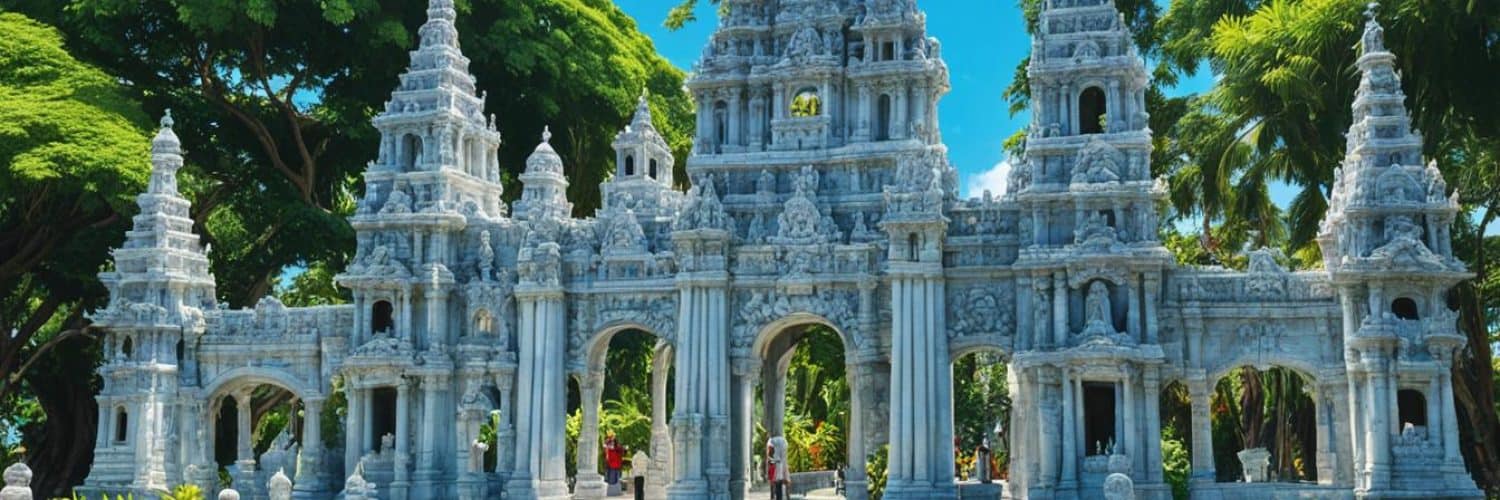The Mactan Shrine is a hidden gem nestled in the heart of Cebu, Philippines. Steeped in history and cultural heritage, this captivating landmark takes visitors on a journey back in time to the legendary Battle of Mactan in 1521. Located in Lapu-Lapu City on Mactan Island, the shrine serves as a testament to the bravery and resilience of the Filipino people.
Key Takeaways:
- Discover the historical significance of the Mactan Shrine in Cebu, Philippines.
- Immerse yourself in the rich cultural heritage of Lapu-Lapu City and Mactan Island.
- Learn about the legendary Battle of Mactan and the heroism of Lapu-Lapu.
- Explore other nearby attractions, such as Magellan’s Cross and Fort San Pedro.
- Experience the vibrant atmosphere of the shrine and witness cultural events like “Kadaugan sa Mactan”.
History of Mactan Shrine
The Mactan Shrine holds a rich historical significance as it commemorates the Battle of Mactan that took place on April 27, 1521. During this battle, Lapu-Lapu and his indigenous warriors bravely fought against Ferdinand Magellan and his Spanish troops. The battle resulted in Magellan’s death, making him the first European to be killed in the Philippines. Lapu-Lapu’s heroism in defending his land against foreign colonization has made him a symbol of Philippine sovereignty.
To understand the importance of the Mactan Shrine, it is essential to delve into the history of the Battle of Mactan. Ferdinand Magellan, a Portuguese explorer sailing under the Spanish flag, arrived in the Philippines in 1521 in search of a western route to the Indies. However, his encounter with the natives of Mactan Island would prove to be his last.
“I alone can take care of my own people.”
Lapu-Lapu, the chieftain of Mactan Island, staunchly resisted the Spanish colonization and the conversion to Christianity that Magellan sought to impose. When Magellan and his crew attempted to assert their authority over the island, a fierce battle ensued. Despite being vastly outnumbered and lacking advanced weaponry, Lapu-Lapu and his warriors fiercely defended their land and culture.
The Battle of Mactan resulted in a significant victory for Lapu-Lapu, with Magellan being mortally wounded during the conflict. The battle, which showcased the resilience and bravery of the native Filipinos against foreign invaders, became a pivotal moment in Philippine history. Lapu-Lapu’s victory marked the first recorded resistance against European colonization in the archipelago, solidifying his status as a national hero.
| Historical Figures | Roles |
|---|---|
| Lapu-Lapu | Native chieftain who led the resistance against Spanish colonization. |
| Ferdinand Magellan | Portuguese explorer who sought to find a western route to the Indies, leading the Spanish colonization efforts. |
The Battle of Mactan and Lapu-Lapu’s heroism at the Mactan Shrine hold immense cultural and historical significance for the Philippines. Today, the Mactan Shrine stands as a testament to the bravery and resilience of the Filipino people, reminding visitors of the nation’s struggle for independence and sovereignty.
Statues at Mactan Shrine
The Mactan Shrine, a symbol of historical significance, is adorned with intricate statues that bring to life the events that unfolded during the Battle of Mactan. These statues serve as a visual representation of the bravery and heroism displayed by the key figures in this historic clash.
Lapu-Lapu Shrine: A Testament to Courage
The most prominent statue at the Mactan Shrine is the Lapu-Lapu Shrine. This awe-inspiring monument features a larger-than-life bronze statue of Lapu-Lapu, a revered native chieftain. With a mighty kampilan in hand, Lapu-Lapu stands tall, symbolizing his unwavering courage, resilience, and determination. This powerful image pays homage to his pivotal role in defeating Ferdinand Magellan during the Battle of Mactan.
Monument of Ferdinand Magellan: A Clash of Cultures
Adjacent to the Lapu-Lapu Shrine, visitors will find the monument dedicated to Ferdinand Magellan. This statue serves as a reminder of the clash of cultures that transpired during the Battle of Mactan. It portrays Magellan, the Portuguese explorer, who sought to bring foreign influence to the shores of the Philippines.
Sculptural Tableau: Commemorating the Battle of Mactan
Within the Mactan Shrine, there is a visually captivating sculptural tableau that vividly portrays the intense Battle of Mactan. This artistic representation showcases the fierce confrontation between Lapu-Lapu’s warriors and the Spanish troops led by Magellan. The tableau serves as a tribute to the bravery and sacrifices made by Lapu-Lapu and his warriors in defense of their homeland.
Significance of Mactan Shrine to Cebu
The Mactan Shrine holds immense significance to the people of Cebu and the Philippines as a whole. It is a source of cultural pride, representing the courage and determination of their ancestors. The shrine also serves as a major tourist attraction, attracting visitors from around the world who are captivated by its historical value. Furthermore, it plays a crucial role in preserving and commemorating the Philippine national identity, embodying the spirit of resilience and heroism.
Located in the vibrant city of Cebu, the Mactan Shrine stands as a testament to the rich history and cultural heritage of the Philippines. It serves as a symbol of cultural pride, reminding the people of Cebu of the bravery exhibited by their forefathers. The shrine preserves the memories of the Battle of Mactan, where Lapu-Lapu, a native chieftain, stood firm against foreign colonization. It is a place of deep historical significance, allowing visitors to connect with their roots and appreciate the courage and resilience of the Filipino people.
As a prominent tourist attraction in Cebu, the Mactan Shrine draws visitors from all corners of the globe. Its historical value and cultural significance make it a must-visit destination for travelers seeking a deeper understanding of Philippine history. Tourists are fascinated by the heroic story of Lapu-Lapu and the Battle of Mactan, immersing themselves in the rich tapestry of Filipino heritage.
Mactan Shrine also plays a crucial role in preserving and commemorating the Philippine national identity. It serves as a reminder of the nation’s struggle for freedom and independence, emphasizing the importance of resilience and the preservation of cultural heritage. The shrine becomes a symbol of unity and national pride, fostering a sense of belonging and inspiring future generations to honor their history.
With its cultural significance, historical relevance, and captivating allure, the Mactan Shrine stands as a testament to the rich tapestry of Cebu’s heritage. It continues to be a beacon of cultural pride, a major tourist attraction, and a symbol of national identity. A visit to the Mactan Shrine is truly an immersive journey into the heart and soul of Cebu and the Philippines.
How to Reach Mactan Shrine
Located on Mactan Island, near Cebu City, Mactan Shrine is easily accessible by land, air, or sea, offering visitors various transportation options.
Land Access
To reach Mactan Shrine by land, visitors can take a taxi or use a ride-sharing service from Cebu City to Lapu-Lapu City. The trip provides a scenic journey, allowing visitors to enjoy the beautiful surroundings of the area.
Air Access
For those traveling by air, Mactan-Cebu International Airport, located on Mactan Island, offers convenient access to the shrine. Travelers can book flights to this international airport from various destinations, making it easily accessible for visitors from around the world.
Sea Access
Sea travel is another option for reaching Mactan Shrine. Ferries are available from different points in the Philippines, connecting to Mactan Island. This mode of transportation allows visitors to enjoy the beauty of the sea and adds an adventurous touch to their journey.
Whether you choose to arrive by land, air, or sea, reaching Mactan Shrine is a convenient and enjoyable experience. The accessibility of the shrine allows visitors to immerse themselves in the historical and cultural significance of this remarkable landmark.
Reminders before Visiting Mactan Shrine
Before embarking on your journey to the Mactan Shrine, keep in mind a few travel tips and important reminders to make the most of your visit. These simple guidelines will help ensure a pleasant experience while exploring this historic site.
Dress Code: When visiting the Mactan Shrine, it is recommended to wear comfortable clothing suitable for the tropical climate of Cebu. Lightweight and breathable fabrics, such as cotton or linen, will help you stay cool and comfortable during your visit.
Cultural Respect: As you immerse yourself in the history and culture of the Mactan Shrine, it is essential to show respect for the site and its significance. Help preserve the sanctity of the shrine by behaving appropriately, refraining from littering, and avoiding any actions that may damage the statues or the surrounding area.
Historical Background: To fully appreciate the historical significance of the Mactan Shrine, take the time to learn about its captivating history before your visit. Familiarize yourself with the Battle of Mactan and the heroism of Lapu-Lapu, as it will enrich your experience and deepen your connection to the site.
Nearby Attractions: The Mactan Shrine is not the only attraction in the area. While exploring this historical landmark, take the opportunity to visit nearby attractions that reflect the rich culture and history of Cebu. Some notable places to explore include the Mactan Island Aquarium, where you can discover the marine wonders of the region, and the Lapu-Lapu City Hall, where you can learn more about the local government and its role in preserving the heritage of the region.
By keeping these reminders in mind, you can ensure a meaningful and respectful visit to the Mactan Shrine. Immerse yourself in its historical significance, embrace the local culture, and create lasting memories of your journey.
Attractions near Mactan Shrine
| Attractions | Description |
|---|---|
| Mactan Island Aquarium | Discover the vibrant marine life of Mactan Island through interactive exhibits and educational displays. |
| Lapu-Lapu City Hall | Explore the city hall to learn about the local government’s efforts in preserving the cultural heritage of Lapu-Lapu City. |
Local Cuisine and Souvenirs
During your visit to Mactan Shrine, don’t miss the opportunity to indulge in the delectable local cuisine of Cebu. Mactan Island, known for its vibrant food scene, offers a wide array of tantalizing dishes that will surely satisfy your taste buds. One of the highlights of the local cuisine is the abundance of fresh seafood, sourced directly from the surrounding waters.
From succulent grilled fish and mouthwatering shrimp dishes to savory crab specialties, seafood lovers will find themselves in paradise. The local chefs skillfully prepare these ocean treasures using traditional recipes, showcasing the unique flavors and freshness of the ingredients.
After enjoying a delightful meal, take some time to explore the souvenir shops located near the shrine. These shops offer a variety of traditional crafts and artworks that beautifully depict the rich culture and heritage of the Philippines. Whether it’s intricately designed wooden figurines, handwoven textiles, or exquisite jewelry, you’ll find the perfect memento to commemorate your visit to Mactan Shrine.
Immerse yourself in the rich flavors and artistic heritage of Mactan Island, taking home not just memories but also a piece of its vibrant culture. Don’t forget to savor the local cuisine and support local artisans by visiting the souvenir shops near the shrine.
| Popular Mactan Island Seafood Dishes | Traditional Crafts and Artworks |
|---|---|
| Fish Sinigang (Sour Soup) | Wooden Figurines |
| Grilled Prawns | Handwoven Textiles |
| Crab Relleno (Stuffed Crab) | Exquisite Jewelry |
| Adobong Pusit (Squid Adobo) | Pottery and Ceramic Art |
| Lapu-Lapu Escabeche (Sweet and Sour Fish) | Shell Crafts |
“The freshness and variety of seafood in Mactan Island are simply unparalleled. Each dish tells a story of the island’s rich marine resources and the skilled hands that transform them into culinary masterpieces.”
The Vibrant Atmosphere of Mactan Shrine
The Mactan Shrine is not just a historical site; it also exudes a vibrant atmosphere filled with cultural events. One event that stands out is the annual “Kadaugan sa Mactan,” which takes place in April and reenacts the famous Battle of Mactan. This lively celebration enhances the dynamic ambiance of the shrine and allows visitors to experience firsthand the rich cultural heritage of the Philippines.
“Kadaugan sa Mactan” immerses visitors in the historical significance of the Battle of Mactan. From the exhilarating reenactments to the colorful parades and cultural performances, this event captures the spirit of bravery and heroism displayed by Lapu-Lapu and his warriors. It truly embodies the vibrant essence of the Mactan Shrine and leaves a lasting impression on all who attend.
Captivating Sights near Mactan Shrine
While the Mactan Shrine is undoubtedly a must-visit destination, there are also other captivating sights and tourist attractions near the area that are worth exploring. These nearby attractions provide an opportunity for visitors to further immerse themselves in Philippine history and culture, making their visit to Mactan Island even more enriching.
1. Magellan’s Cross
One of the most iconic landmarks in Cebu City, Magellan’s Cross holds great historical significance. It is believed to be the very cross planted by Ferdinand Magellan upon his arrival in the Philippines in 1521, marking the introduction of Christianity to the country. Located just a short distance from the Mactan Shrine, this historic site offers a glimpse into the colonial past of the Philippines.
2. Fort San Pedro
Fort San Pedro, a Spanish-era military defense structure, is another nearby attraction that should not be missed. Built in the 17th century, this triangular fort served as a stronghold against Dutch and Muslim invaders during that time. Today, it houses a museum showcasing artifacts and exhibits related to Cebu’s history. Exploring the fort’s cannons, ramparts, and lush gardens is a fascinating experience that provides a deeper understanding of the city’s past.
3. Basilica Minore del Santo Niño
The Basilica Minore del Santo Niño is the oldest Roman Catholic church in the Philippines. Located in Cebu City, it houses the Santo Niño, a religious icon believed to be miraculous. The basilica attracts millions of devotees and tourists every year, especially during the Sinulog Festival, a grand celebration in honor of the Santo Niño. Visitors can witness the intricate architectural design of the church and immerse themselves in the spiritual ambiance that surrounds it.
These nearby attractions offer a diverse range of experiences, from delving into the colonial history at Magellan’s Cross to exploring the military heritage at Fort San Pedro and embracing the spiritual devotion at the Basilica Minore del Santo Niño. Adding these destinations to your itinerary will allow you to make the most out of your sightseeing adventure near the magnificent Mactan Shrine.
Discover the Mactan Shrine: A Journey Back in Time
A visit to the Mactan Shrine offers a unique opportunity to embark on a historical journey that takes you back in time. This significant site educates visitors about the heroism of Lapu-Lapu, the cultural heritage of the Battle of Mactan, and the enduring spirit of national pride. It serves as a vivid reminder of the rich heritage and remarkable legacy of the Philippines.
The Mactan Shrine stands as a testament to the valor and bravery of Lapu-Lapu, a native chieftain who fiercely defended his land against foreign colonization. As you explore this historic landmark, you’ll gain a deeper understanding of the struggles and triumphs that shaped the nation’s identity.
Education plays a vital role at the Mactan Shrine, offering visitors an immersive experience into the historic events that unfolded on its grounds. The shrine serves as an engaging educational resource, teaching people about the Battle of Mactan and the pivotal role it played in Philippine history. Through interactive exhibits, informative displays, and guided tours, visitors can delve into the past, unraveling the layers of heroism and sacrifice that define the Mactan Shrine.
Preserving heritage is of utmost importance at the Mactan Shrine, ensuring that future generations can continue to appreciate and learn from the lessons of the past. The shrine serves as a beacon of national pride, instilling a sense of awe and reverence for the country’s cultural roots. As you navigate through the Mactan Shrine, you’ll witness the enduring legacy of heroism, igniting a deep sense of national pride within you.
Exploring the Mactan Shrine is a captivating experience that not only educates but also inspires. It provides a profound insight into the resilience and determination of the Filipino people, highlighting the values that have shaped the nation. Whether you’re a history enthusiast, a student seeking a deeper understanding of Philippine heritage, or simply a curious traveler, the Mactan Shrine offers an enriching and rewarding adventure that transcends time.
Conclusion
In conclusion, the Mactan Shrine in Cebu, Philippines, is a historical landmark and cultural heritage site that holds significant importance. This iconic shrine serves as a testament to the bravery and resilience of the Filipino people, especially Lapu-Lapu and his triumph in the Battle of Mactan.
As a tourist destination, the Mactan Shrine attracts visitors from all over the world who are eager to delve into the rich history and immerse themselves in the vibrant cultural heritage of the Philippines. The shrine offers a unique opportunity for travelers to discover the remarkable legacy of Lapu-Lapu and the pivotal events that shaped Philippine history.
Visiting the Mactan Shrine is not only a chance to witness a historical landmark but also a journey to appreciate the enduring spirit of the Filipino people. It serves as a reminder of the nation’s cultural pride and national identity, preserving the heroic acts of the past for generations to come. Whether you are a history enthusiast or simply looking for a captivating tourist destination, the Mactan Shrine is an experience that should not be missed.
FAQ
What is the Mactan Shrine?
The Mactan Shrine is a significant historical landmark located in Lapu-Lapu City, Cebu, Philippines. It serves as a monument to the legendary Battle of Mactan in 1521, where Lapu-Lapu, a native chieftain, defeated Ferdinand Magellan, the Portuguese explorer.
What is the significance of the Battle of Mactan?
The Battle of Mactan, which took place on April 27, 1521, holds immense historical significance. Lapu-Lapu and his indigenous warriors fought against Ferdinand Magellan and his Spanish troops, resulting in Magellan’s death and making him the first European to be killed in the Philippines. Lapu-Lapu’s heroism has made him a symbol of Philippine sovereignty.
What statues can be found at the Mactan Shrine?
The Mactan Shrine is adorned with several statues. The most prominent among them is the Lapu-Lapu Shrine, featuring a larger-than-life bronze statue of Lapu-Lapu wielding a kampilan (Filipino sword). There is also a monument dedicated to Ferdinand Magellan, highlighting the clash of cultures, and a sculptural tableau depicting the Battle of Mactan.
Why is the Mactan Shrine important to the people of Cebu?
The Mactan Shrine is a source of cultural pride for the people of Cebu and the Philippines as a whole. It represents the courage and determination of their ancestors in defending their land. Additionally, it is a major tourist attraction that attracts visitors from around the world, contributing to the preservation and commemoration of the Philippine national identity.
How can I reach the Mactan Shrine?
The Mactan Shrine is located on Mactan Island, near Cebu City. Visitors can reach the shrine by land, air, or sea. By land, one can take a taxi or ride-sharing service from Cebu City to Lapu-Lapu City. By air, travelers can fly into Mactan-Cebu International Airport located on Mactan Island. And by sea, there are ferries available from various points in the Philippines that connect to Mactan Island.
What should I know before visiting the Mactan Shrine?
Before visiting the Mactan Shrine, it is advisable to wear comfortable clothing suitable for the tropical climate. Visitors should also show respect for the site by behaving appropriately and refraining from littering or damaging any part of the shrine. It is recommended to learn about the history of the Mactan Shrine beforehand to enhance your experience. Additionally, visitors can explore nearby attractions such as the Mactan Island Aquarium and Lapu-Lapu City Hall to further immerse themselves in the local culture and history.
What can I expect to find near the Mactan Shrine?
During your visit to the Mactan Shrine, be sure to sample some of the delicious local Cebuano cuisine, especially the fresh seafood for which Mactan Island is known. There are also souvenir shops located near the shrine where visitors can purchase mementos, such as traditional crafts and artworks, to commemorate their visit.
Are there any cultural events held at the Mactan Shrine?
Yes, the Mactan Shrine is not only a historical site but also a hub for cultural events. One notable event is the “Kadaugan sa Mactan” held annually in April, which reenacts the Battle of Mactan. This celebration adds to the vibrant atmosphere of the shrine and offers visitors a unique opportunity to witness the rich cultural heritage of the Philippines.
What other attractions are there near the Mactan Shrine?
Apart from the Mactan Shrine, there are other captivating sights and tourist attractions near the area. Visitors can explore nearby attractions such as Magellan’s Cross, Fort San Pedro, and the Basilica Minore del Santo Niño to further immerse themselves in Philippine history and culture.
What can I learn from visiting the Mactan Shrine?
A visit to the Mactan Shrine offers a unique opportunity to embark on a journey back in time. This historical site educates visitors about the heroism of Lapu-Lapu, the significance of the Battle of Mactan, and the enduring spirit of national pride. It serves as a reminder of the rich heritage and cultural legacy of the Philippines.











Add comment